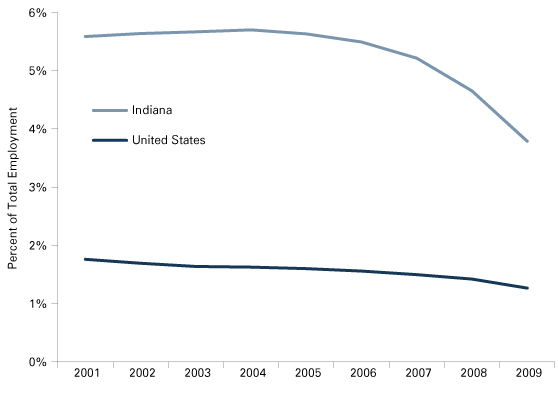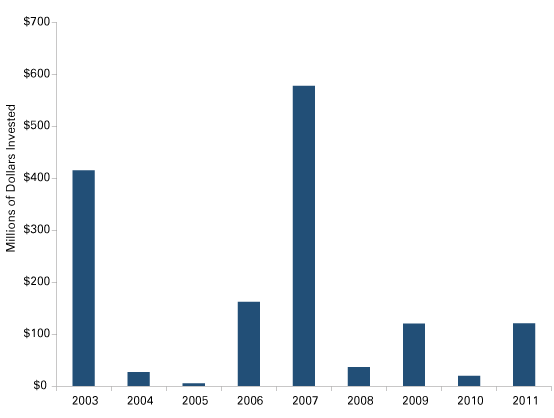European Investment in Indiana’s Automotive Sector
Economic Research Analyst, Indiana Business Research Center, Indiana University Kelley School of Business
Indiana, as well as the rest of the Midwest, boasts a proud tradition of automotive manufacturing. Historically, transportation equipment has been Indiana's biggest export, although that distinction has become tenuous in recent years. The percentage of Indiana's employment devoted to transportation equipment manufacturing is more than three times the corresponding percentage for the nation as a whole. That figure, however, has decreased considerably over time. In 2001, transportation equipment manufacturing accounted for 5.6 percent of Indiana's employment. In 2009, that figure dropped to 3.8 percent. For the United States as a whole, the decrease was less dramatic, from 1.8 percent to 1.3 percent.
As Figure 1 shows, the most recent recession has proved particularly devastating to Indiana's transportation equipment manufacturing employment, although the drop in employment in this sector began as early as 2004. But transportation equipment remains a major player in the Indiana economy.
Figure 1: Percentage of Total Employment Devoted to Transportation Equipment Manufacturing, 2001-2009

Source: IBRC, using Bureau of Labor Statistics data
A Snapshot of Europe's Investment
Foreign investment in Indiana's motor vehicle manufacturing activity has ballooned over the last half-decade, particularly from the European Union (EU). EU firms' estimated investment in Indiana in transportation equipment has totaled close to $1.5 billion since 2003. This investment has resulted in the creation of more than 5,300 jobs in the state, or roughly 6 percent of the total 2009 transportation equipment manufacturing employment in Indiana. Relatively speaking, Europe is a prominent player in the transportation equipment manufacturing industry in Indiana.
Figure 2 shows the estimated dollar value of EU investments in Indiana's transportation equipment industries in each year since 2003.
Figure 2: European Investment in Indiana Transportation Equipment Manufacturing

Source: IBRC, using FDI Markets data
These investments came from 21 separate European firms. The top five EU investors are shown in Table 1. The lion's share of investment was derived from DaimlerChrysler, the German-owned firm created when Daimler merged with U.S. car company Chrysler in 1998. Daimler divested its interest in Chrysler in 2007, and so 2007 is the last year in which the combined firm is recorded as investing in Indiana. After a couple of years as a privately owned firm, Chrysler was sold to Italian auto firm Fiat in 2009. A review of the specific investments DaimlerChrysler made in Indiana reveals two investments, both of substantial value, and both directed at Chrysler's Kokomo manufacturing facility. So, while the German firm is no longer supplying the funds, Chrysler remains financially tied to the EU through its corporate parent, Fiat.
Table 1: Top Five European Investors in Transportation Equipment Manufacturing, 2003 to 2011
| Investor | Source Country | Total Estimated Investment |
|---|---|---|
| DaimlerChrysler | Germany | $938,000,000 |
| Rolls-Royce Group | United Kingdom | $254,100,000 |
| ThyssenKrupp | Germany | $53,750,000 |
| Michelin | France | $50,000,000 |
| BAE Systems | United Kingdom | $31,900,000 |
Source: IBRC, using FDI Markets data
Rolls-Royce Group, a U.K. firm, has invested over a quarter of a billion dollars in its Indiana operation since 2003. Rolls-Royce focuses its production on vehicles for air and sea, but its involvement in the Indiana economy has real implications for a workforce trained in the manufacturing of motor vehicle parts. For instance, Rolls-Royce's most recent investment in the state, announced just last January 2011, will inject almost $50 million into Indianapolis for the purpose of designing engine control systems. This project is estimated to generate 159 new jobs by 2013. Engine design is obviously an integral component of the automotive supply chain, and regardless of the engines' ultimate use, the activity fits well with Indiana's strength in parts manufacturing.
ThyssenKrupp, a global technology holding company based in Germany, is also on the list. This EU firm has invested over $50 million in Indiana for the purposes of producing automotive components, primarily in Terre Haute. In 2009, a U.S. subsidiary of ThyssenKrupp expanded its metal casting operations in Tell City, Ind., with a $36.5 million investment. The project was intended to upgrade equipment and expand capacity at the plant. This was expected to create 160 jobs by the end of 2012, which is not negligible in a town of just over 7,000 people.
In January 2011, French tire manufacturer Michelin announced a single $50 million investment through its subsidiary, BF Goodrich. The investment will go to BF Goodrich's existing tire plant in Woodburn, Ind. This grant will expand the operation's current tire production facility and add 35 new jobs. Since Woodburn's population is just over 1,500 people, this project will have about the same per capita impact on employment in Woodburn as the ThyssenKrupp project will have on employment in Tell City.
BAE Systems is a U.K. defense and security firm that provides products and services for land, air and naval forces. In 2009, the company invested almost $15 million to add 200 jobs to its production facility in Fort Wayne. The facility manufactures engine controls, flight controls, and cables for commercial and military avionics. The new jobs that the investment funds brought were to be operations, operations support and engineering positions.1
In addition to these larger foreign investors, several other smaller players have recently found Indiana's manufacturing capability to be an opportune investment vehicle. In just the past year, four other European firms have announced investments totaling $32 million, with each granted to a facility in a different city. All four firms are involved in the automotive industry.
Table 2: Recent European Investors in Indiana's Automotive Industry
| Announcement Date | Company Name | Source Country | Destination City | Investment | Jobs |
|---|---|---|---|---|---|
| March 1, 2011 | Somaschini | Italy | South Bend | $18,000,000 | 12 |
| February 1, 2011 | AL-KO Kober | Germany | Elkhart | $4,500,000 | 21 |
| September 1, 2010 | Voss | Germany | Fort Wayne | $2,500,000 | 9 |
| July 1, 2010 | Dallara Automobili | Italy | Speedway | $7,000,000 | 80 |
Source: IBRC, using FDI Markets data
Somaschini is an Italian manufacturer of a wide array of gears for automotives. The company's recent $18 million investment in South Bend is not an expansion but a new project, a joint venture with Schafer Gear Works. The joint venture, named South Bend Gear, will produce engine gears for heavy-duty trucks to be marketed in North America.
AL-KO Kober announced a $4.5 million expansion of its operations in Elkhart in order to manage an expected 20 percent rise in sales this year. The German company produces a diverse catalog of machinery and engineering products, but focuses on the manufacture of axles and brakes. The Elkhart facility was the launching point of AL-KO Kober's U.S. operations almost 30 years ago.2
Another German automobile components producer, Voss, — specializing in air brake, fuel, and metric fittings, lines and valves—announced in 2010 that they were going to invest in Fort Wayne. Their plans call for adding office, lab and warehouse space to the existing production facility, as well as additional staff.
Finally, in November 2010, Italian race car designer and manufacturer Dallara Automobili broke ground in Speedway on a $7 million production facility, the company's first outside its hometown of Parma, Italy.3 Dallara Automobili is well-known for providing the chassis for the IndyCar series. The new production facility will bring 80 new jobs.
What the Future Holds
Europe's investment in Indiana's motor vehicle industry is likely to continue increasing. The largest investor over the last eight years was Chrysler. While Fiat currently owns only 30 percent of Chrysler, the Italian firm recently announced that it may exercise an option to purchase up to 70 percent.4 This would substantially increase the parent company's involvement in Indiana's—and the Midwest's—automotive industry.
Other new developments also portend greater European involvement. Manufacturing in Indiana and the Midwest is currently undergoing a fundamental change as motor vehicle producers clamber to produce "greener" and more fuel- efficient products. A recent report on changes in the auto industry revealed that while the Midwest is in many ways poised to take advantage of increases in the technological sophistication and efficiency of new vehicles, in other ways Europe and Asia have the upper hand.5 For instance, one change facing the auto industry today is the need to produce more fuel-efficient vehicles without sacrificing the size of the vehicle. This requires lighter raw materials, and the U.S. lags behind Europe and Asia in the fields of metallurgy and material science, which are necessary to create these new materials. As such, European firms will likely play an even bigger role in U.S. auto manufacturing as time progresses and the needs of the industry exceed the nation's traditional competencies.
European firms who provide such raw materials have begun to invest in Indiana. In 2008, Luxembourg-based steel giant ArcelorMittal announced a $240 million expansion of its production facility in New Carlisle, Ind. The investment would create a new galvanizing line, resulting in 100 new jobs. Most important for the greening U.S. auto industry, however, the new line would produce "high-grade, high-quality coated sheets that promote improved safety and fuel efficiency in automobiles." 6 The company credited the Indiana Economic Development Corporation's provision of training grants and tax credits with making Indiana the most attractive location for its business. Many of the European vehicle and parts producers mentioned above also noted Indiana's tax breaks and employee training grants as critical factors in their decisions to invest in the state.
Training grants are particularly important as the industry moves toward producing more technologically advanced and environmentally friendly products. At times like these, when demand for vehicles has stagnated and cash is scarce, providing training in-house or contracting it out can be difficult or infeasible for manufacturers. In the report mentioned above, employers in the motor vehicle industry indicated that state government support for skill development and training attracted them to the South, as opposed to the Midwest.7 While statements from firms already investing in Indiana attest to the value of this state's support for training, there might still be room for improvement.
With the greening of the automotive industry, Indiana has become one of the prime locations in the United States for manufacturers of electric vehicle batteries and engines.8 Given Europe's edge in producing green technologies, specializing in electric vehicle inputs might put Indiana on the radar of European auto manufacturers looking to produce greener cars on American soil. Our less expensive workforce and government incentives would only increase the Hoosier state's attractiveness. Signs are already emerging that European producers of battery-powered cars are looking to the United States as a manufacturing venue. German automaker BMW announced in late 2010 that the carbon fiber for its new line of Megacity electric vehicles would come from a plant in the state of Washington.9 As automakers around the world introduce and expand lines of battery-powered cars, Indiana stands ready to capitalize on that growth.
Conclusion
What this review of European foreign direct investment in Indiana reveals is that Europe is playing an increasingly important role in Indiana's transportation equipment industry and, perhaps more importantly, is entering the state at all stages of the automotive supply chain. Just the few examples discussed here span the range of components used to produce finished vehicles: engines, gears, axles, brakes, bodies, etc. In addition, the end users of the products range from individual civilians to businesses to the military. Given the importance of the motor vehicle industry—and especially the motor vehicle parts industry—to Indiana's economy, European firms' continued willingness to invest their capital here can only be viewed as a positive sign for the state's economic prospects.
This research was sponsored by the European Union Center at Indiana University through a grant from the European Union.
Notes
- Aaron Organ, "BAE Systems to Add 200 Jobs in Fort Wayne," News-centinal.com, February 28, 2009, accessed May 6, 2011.
- Source: www.al-kousa.com.
- "Dallara and Indy Racing Experience Break Ground on New Speedway Home," Indy Racing Experience, www.indyracingexperience.com, November 16, 2010, accessed May 6, 2011.
- "Fiat Has Options to Boost Chrysler Stake to More than 70%," Automotive News Europe, May 10, 2011, http://autonewseurope.com/apps/pbcs.dll/article?AID=/20110510/ANE/305109869/1193.
- Driving Change Consortium, "Driving Workforce Change: Regional Impact and Implications of Auto Industry Transformation to a Green Economy," a report prepared for the Employment and Training Administration, U.S. Department of Labor, May 2011, www.drivingworkforcechange.org/reports/DrivingWorkforceChange.pdf.
- ArcelorMittal and Nippon Steel Corporation Announce $240 Million Expansion at I/N Kote in New Carlisle, Indiana," ArcelorMittal, April 16, 2008, www.arcelormittal.com/corp/news-and-media/press-releases/2008/apr/16-04-2008a?lang=english.
- Driving Change Consortium, "Driving Workforce Change: Regional Impact and Implications of Auto Industry Transformation to a Green Economy," a report prepared for the Employment and Training Administration, U.S. Department of Labor, May 2011, www.drivingworkforcechange.org/reports/DrivingWorkforceChange.pdf.
- Timothy Slaper, "Ion Drive: A Visit to Enerdel," Indiana Business Review, Summer 2010, www.ibrc.indiana.edu/ibr/2010/summer/pdfs/summer2010.pdf.
- Jack Ewing, "BMW Inaugurates a Factory for Electric Cars," The New York Times, November 6, 2010, www.nytimes.com/ 2010/11/06/business/global/06bmw.html.
Also in this Issue…




